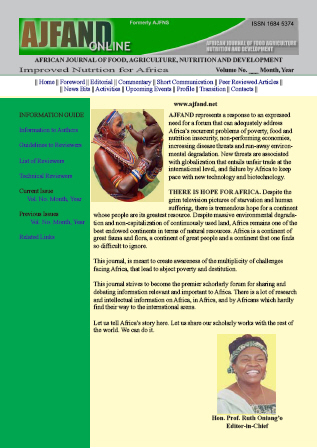
|
African Journal of Food, Agriculture, Nutrition and Development
Rural Outreach Program
ISSN: 1684-5358
EISSN: 1684-5358
Vol. 20, No. 3, 2020, pp. 15800-15820
|
 Bioline Code: nd20039
Bioline Code: nd20039
Full paper language: English
Document type: Research Article
Document available free of charge
|
|
|
African Journal of Food, Agriculture, Nutrition and Development, Vol. 20, No. 3, 2020, pp. 15800-15820
| en |
RELATIONSHIP BETWEEN SPOT AND FUTURES PRICES: THE CASE OF GLOBAL FOOD COMMODITIES
Samak, N; Hosni, R & Kamal, M
Abstract
Global debates about determining the direction of relationship between commodity futures and spot prices reflect the importance of this issue. Resolving the debate will guide different economic agents to make correct decisions. The aim of this paper is to empirically investigate the direction of relationship between food spot and futures prices using different methodologies so as to resolve the debate. In addition, it is important to know which market could cause price volatilities to the other market, and thus, addressing price volatilities in a correct way. The paper conducts linear and non-linear Granger causality tests along with cointegration and error correction model and concludes with mixed findings. Specifically, linear and nonlinear Granger causality tests found evidence that food futures prices cause food spot prices. This suggests that food futures markets lead the price discovery process, and hence, the direction of information flows goes from food futures markets to food spot markets, and accordingly, any price volatilities in futures markets lead to price volatilities in spot markets. In contrast, the cointegration and error correction model found evidence that food spot prices cause food futures prices. This suggests that food spot markets lead the price discovery process, and hence, the direction of information flows goes from food spot markets to food futures markets, and accordingly any price volatilities in food spot markets lead to price volatilities in futures markets. Based on these differences in the obtained results, the current paper suggests the cointegration and error correction model is preferable since it provides a more formal framework for examining the short-run dynamics and testing for the equilibrium relationship among economic variables. Special attention to alternative instruments, such as the implementation of a global virtual reserve, should be highlighted so as to minimize speculative attacks and avoid excessive spikes of prices in spot and futures markets. This implies the importance of adopting the possible protectionist measures by developing countries in order to hedge against the negative reflections of global food price volatility.
Keywords
Food markets; futures prices; spot prices; causality tests; cointegration analysis
|
| |
© Copyright [2020] - African Journal of Food, Agriculture, Nutrition and Development
Alternative site location: http://www.ajfand.net/
|
|
